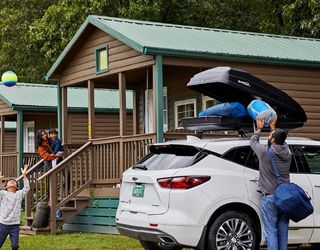So, you’ve finally taken the plunge and bought a roof box! Congratulations on your newfound sense of freedom and storage space. But how do you make sure all your precious cargo is safe and sound during your epic road trips? Fear not, dear reader! We’re here to guide you on the wild and wonderful journey of securing your belongings inside a roof box. Buckle up and let’s get started!
Types of Roof Boxes
First, let’s talk about the types of roof boxes available to you. There are two main categories: hard shell and soft shell. Each has its own set of benefits and drawbacks, but one thing they have in common is the need to secure your belongings properly.
- Hard Shell: These roof boxes are made from durable materials like ABS plastic or fiberglass, which offer excellent protection for your belongings. They can handle the weight and are easy to clean. However, they can be pricey and require proper installation.
- Soft Shell: Made from weather-resistant fabric, these roof boxes are more affordable and easier to store. However, they might not offer the same level of protection as hard shell boxes.
Roof Box Brands
With a plethora of roof box brands on the market, it can be tough to decide which one is right for you. Do your research and read customer reviews to find the brand that meets your needs and budget. Some popular brands include Thule, Yakima, and Rhino-Rack.
Weight Limit
Now, let’s talk about the weight limit of your roof box. It’s crucial to know the maximum weight your box can handle, as exceeding this limit can damage your box, vehicle, or even worse, cause an accident. Check the manufacturer’s guidelines and follow them religiously.
Installation
Proper installation is key to ensuring the safety of your belongings. Most roof boxes come with a mounting system, but it’s essential to double-check that it’s compatible with your vehicle. If you’re unsure, consult a professional or the manufacturer for guidance.
Materials
Roof boxes are made from various materials that offer different levels of protection and durability. Consider the weather conditions you’ll be traveling in and choose a roof box made from a material that can withstand those conditions.
Maintenance
Regular maintenance is necessary to keep your roof box in top shape. Check for any wear and tear, clean it regularly, and always store it properly when not in use.
Hard Shell vs Soft Shell
The eternal debate: hard vs soft shell roof boxes. Hard shell boxes provide better protection and are more durable, but they can be pricey and harder to store. Soft shell boxes are more affordable and easier to store, but they might not offer the same level of protection. Ultimately, it’s up to you to decide which type best suits your needs and budget.
Securing Belongings
Ah, the pièce de résistance! Securing belongings inside your roof box is crucial to prevent shifting and damage. Follow these tips to keep your cargo safe and sound:
- Pack heavier items on the bottom and lighter items on top.
- Use straps or bungee cords to secure items in place.
- Fill empty spaces with soft items, like blankets or clothes, to prevent items from moving around.
- Distribute the weight evenly across the roof box.
- Regularly check and adjust straps or cords during your trip.
Aerodynamic Design
An aerodynamic design not only looks cool, but it also reduces wind resistance, noise, and fuel consumption. Make sure your roof box is sleek and aerodynamic for a smooth, fuel-efficient ride.
Legality and Restrictions
Be aware of any legality and restrictions related to roof boxes in your area or the places you plan to visit. Some places have height, width, or weight restrictions, so plan accordingly to avoid fines or other issues.
Removal
Removal of your roof box should be done carefully to avoid damage to your vehicle or belongings. Always follow the manufacturer’s instructions and seek assistance if necessary.
Weather Impact
Be prepared for the weather impact on your roof box. Rain, snow, and extreme temperatures can affect the performance and durability of your roof box, so choose one made from weather-resistant materials and regularly check for any signs of wear or damage.
Storage Options
When not in use, store your roof box properly to prolong its life. Consider the available storage options, such as wall-mounted brackets or storage bags, to keep your roof box safe and clean when not in use.
Roof Box vs Rack vs Trailer
Still undecided between a roof box, rack, or trailer? Each option has its pros and cons, but it ultimately depends on your specific needs, budget, and vehicle compatibility.
Conclusion
In conclusion, securing your belongings inside a roof box is essential for a safe and enjoyable road trip. By following the tips outlined in this article, you can ensure that your items stay protected and prevent any shifting or damage. Happy travels!
FAQs
- What is the best way to secure items inside a roof box?
Use straps or bungee cords to secure items in place, and fill empty spaces with soft items to prevent items from moving around.
- How can I prevent my roof box from making too much noise?
Choose an aerodynamic design to reduce wind resistance and noise.
- Are there any legal restrictions for using a roof box?
Some places have height, width, or weight restrictions. Check the regulations in your area or the places you plan to visit.
- What should I consider when choosing a roof box material?
Consider the weather conditions you’ll be traveling in and choose a material that can withstand those conditions.
- Can I store my roof box on my vehicle when not in use?
It’s not recommended, as it can affect your vehicle’s fuel efficiency and expose your roof box to unnecessary wear and tear.




![The [year] Thule Roof Box Buyers Guide best thule roof boxes](https://www.rackstrapgo.com/wp-content/uploads/2022/08/best-thule-roof-boxes-1-150x150.jpg)

